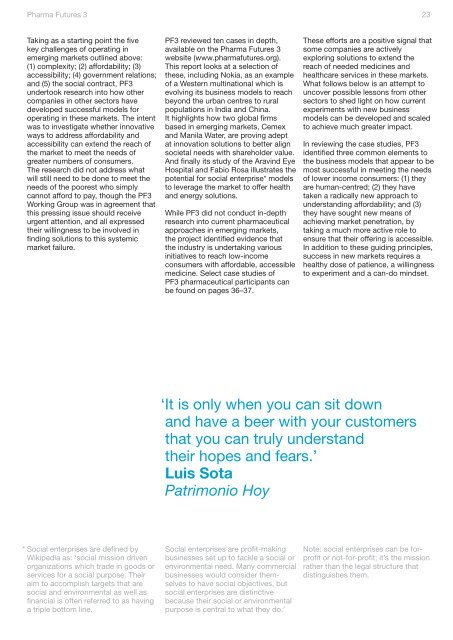Pharma Futures 3 Emerging Opportunities
Pharma Futures 3 Emerging Opportunities
Pharma Futures 3 Emerging Opportunities
You also want an ePaper? Increase the reach of your titles
YUMPU automatically turns print PDFs into web optimized ePapers that Google loves.
<strong>Pharma</strong> <strong>Futures</strong> 3<br />
Taking as a starting point the five<br />
key challenges of operating in<br />
emerging markets outlined above:<br />
(1) complexity; (2) affordability; (3)<br />
accessibility; (4) government relations;<br />
and (5) the social contract, PF3<br />
undertook research into how other<br />
companies in other sectors have<br />
developed successful models for<br />
operating in these markets. The intent<br />
was to investigate whether innovative<br />
ways to address affordability and<br />
accessibility can extend the reach of<br />
the market to meet the needs of<br />
greater numbers of consumers.<br />
The research did not address what<br />
will still need to be done to meet the<br />
needs of the poorest who simply<br />
cannot afford to pay, though the PF3<br />
Working Group was in agreement that<br />
this pressing issue should receive<br />
urgent attention, and all expressed<br />
their willingness to be involved in<br />
finding solutions to this systemic<br />
market failure.<br />
*<br />
Social enterprises are defined by<br />
Wikipedia as: ‘social mission driven<br />
organizations which trade in goods or<br />
services for a social purpose. Their<br />
aim to accomplish targets that are<br />
social and environmental as well as<br />
financial is often referred to as having<br />
a triple bottom line.<br />
PF3 reviewed ten cases in depth,<br />
available on the <strong>Pharma</strong> <strong>Futures</strong> 3<br />
website (www.pharmafutures.org).<br />
This report looks at a selection of<br />
these, including Nokia, as an example<br />
of a Western multinational which is<br />
evolving its business models to reach<br />
beyond the urban centres to rural<br />
populations in India and China.<br />
It highlights how two global firms<br />
based in emerging markets, Cemex<br />
and Manila Water, are proving adept<br />
at innovation solutions to better align<br />
societal needs with shareholder value.<br />
And finally its study of the Aravind Eye<br />
Hospital and Fabio Rosa illustrates the<br />
potential for social enterprise* models<br />
to leverage the market to offer health<br />
and energy solutions.<br />
While PF3 did not conduct in-depth<br />
research into current pharmaceutical<br />
approaches in emerging markets,<br />
the project identified evidence that<br />
the industry is undertaking various<br />
initiatives to reach low-income<br />
consumers with affordable, accessible<br />
medicine. Select case studies of<br />
PF3 pharmaceutical participants can<br />
be found on pages 36–37.<br />
23<br />
These efforts are a positive signal that<br />
some companies are actively<br />
exploring solutions to extend the<br />
reach of needed medicines and<br />
healthcare services in these markets.<br />
What follows below is an attempt to<br />
uncover possible lessons from other<br />
sectors to shed light on how current<br />
experiments with new business<br />
models can be developed and scaled<br />
to achieve much greater impact.<br />
In reviewing the case studies, PF3<br />
identified three common elements to<br />
the business models that appear to be<br />
most successful in meeting the needs<br />
of lower income consumers: (1) they<br />
are human-centred; (2) they have<br />
taken a radically new approach to<br />
understanding affordability; and (3)<br />
they have sought new means of<br />
achieving market penetration, by<br />
taking a much more active role to<br />
ensure that their offering is accessible.<br />
In addition to these guiding principles,<br />
success in new markets requires a<br />
healthy dose of patience, a willingness<br />
to experiment and a can-do mindset.<br />
‘It is only when you can sit down<br />
and have a beer with your customers<br />
that you can truly understand<br />
their hopes and fears.’<br />
Luis Sota<br />
Patrimonio Hoy<br />
Social enterprises are profit-making<br />
businesses set up to tackle a social or<br />
environmental need. Many commercial<br />
businesses would consider themselves<br />
to have social objectives, but<br />
social enterprises are distinctive<br />
because their social or environmental<br />
purpose is central to what they do.’<br />
Note: social enterprises can be forprofit<br />
or not-for-profit; it’s the mission<br />
rather than the legal structure that<br />
distinguishes them.



